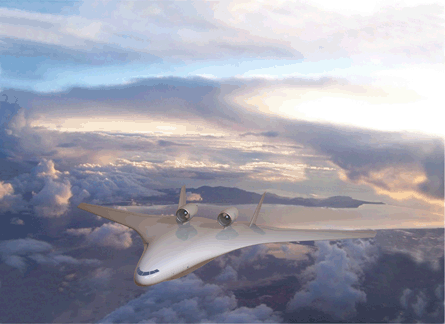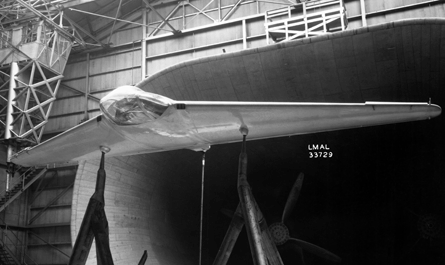As rising fuel costs and pressure to cut emissions drive most of the aviation industry to seek even small improvements in aircraft efficiency, NASA is pushing to mature technologies that may realise in the 2020s an aircraft concept that could slash fuel consumption by up to a third.
The so-called flying wing, or blended wing body, is not a new idea. Serious work on the concept goes back to the 1940s, but only now with a coming together of composite material construction and computer-aided fly-by-wire control are its huge gains in aerodynamic efficiency realistically achievable.
SOMETHING NEW?
NASA first examined flying wing ideas in 1943 when it was still the National Advisory Committee for Aeronautics, or NACA. Now, its environmentally responsible aviation project leader Fayette Collier says: "We call [our flying wing] N2A. It is a configuration we are working on pretty hard."
 |
|---|
 |
© NASANASA's N2A concept (top) and Northrop's 1940s flying wing |
Unlike a traditional wing-and-tube design, blended wing bodies generate lift using the entire airframe, reducing the power needed for take-off. And, the aerodynamics of the overall shape offers much lower drag, in part because the purest concepts have no vertical tail fin.
Moreover, past studies have shown that BWB designs could fit into the 80m (260ft) "box" that airport designs assume as the limit for parking and manoeuvrability. A BWB could carry up to 1,000 people, making such a future US product a challenger to Airbus's A380 and future stretched versions.
NASA'S NEW ERA OF RESPONSIBILITY NASA's environmentally responsible aviation project, or ERA, is part of its integrated systems research into system-level concepts and technologies to cut fuel burn, noise, and emissions. Propulsion concepts and technologies for a blended wing body aircraft type, referred to by NASA as the N+2 vehicle, are of particular focus. The work will also assess technologies in relation to safety improvements. As well as blended wing body work, nitrogen oxide-reducing engine combustor concepts including fuel injector designs will be examined. Other engine work includes an assessment of the acoustics of the ultra-high bypass geared turbofan. Pratt & Whitney PW1000G GTF's ultra-high bypass ratio is 18 - today's engines have a ratio of less than 10. The ERA project, begun following recommendations from the US National Research Council, the Executive Office of the US president, the US Congress and NASA's own advisory council, has a budget of $83 million for fiscal year 2011, rising to $85 million in FY2012 and then scaling down to $77 million by 2015. |
However, the BWB shape poses significant challenges that could not be overcome by early attempts to make such an aircraft, including by Northrop in the 1940s. One is low-speed control, which in the absence of a tailfin becomes a complicated issue that can only be addressed by a sophisticated, computer flight-control system.
The Northrop Grumman B-2 stealth bomber is an example of a successful BWB design, but as the crash on take-off in 2008 of one example of that $2 billion type apparently demonstrated, any failure of the flight-control system is catastrophic.
Collier's project will flight-test a scale-model variant of a BWB concept called X-48C. NASA previously flew the scale model X-48B that was powered by small turbojets at its Dryden Flight Research Center in California. Those flights were low-speed controllability trials that end later this month. The X-48C, also to be flown at Dryden, will be powered by ducted fans to lengthen flight times to enable more work to be done. A full-scale BWB would use turbofan engines and if NASA proves it useful, it could even use open rotors.
The X-48C will be used to examine how the aircraft's shape, with its engines mounted aft and above the body, helps to shield the ground from engine noise on take-off and approach. In addition to this N2A concept, which features tail fins to contribute to noise shielding and flight control, NASA has an N2B concept for embedded propulsion and an unnamed third version, with no tail fins, optimised for fuel burn.
KEEPING IT TOGETHER
Structurally, BWBs pose new challenges compared with conventional tube fuselages and will rely on carbonfibre composites. Composites are needed to reduce the weight of a BWB compared with a metal version, and also should enable construction of a odd-shaped cabin capable of maintaining internal pressure.
However, such structures are vulnerable to carbonfibre delamination, in which layers of carbonfibre, which are held together normally by resin, separate under repeated loading. NASA work in the 1990s found that a stitching technique it calls Perseus - protruded rod stitched efficient unitised structure - can help with this problem.
Critically, Collier's project in 2012 will also see a structural test at the NASA Langley Research Center simulating flight conditions full-scale pressurised noncircular Perseus composite fuselage section.
So is an all-composite BWB airframe on the horizon? Collier's comment that the environmentally responsible aviation programme is aimed at "low hanging fruit" that will deliver green aviation suggests "yes".
Source: Flight International























